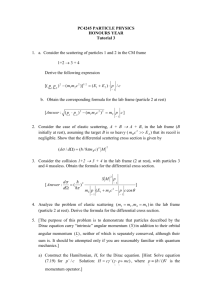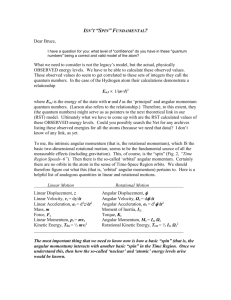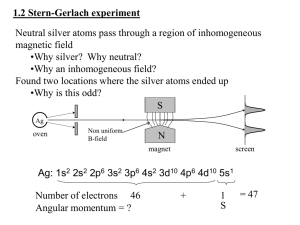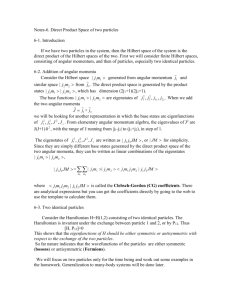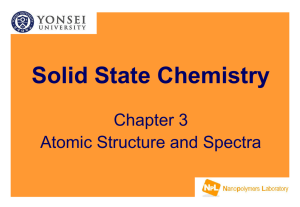lecturenotes2012_10
advertisement
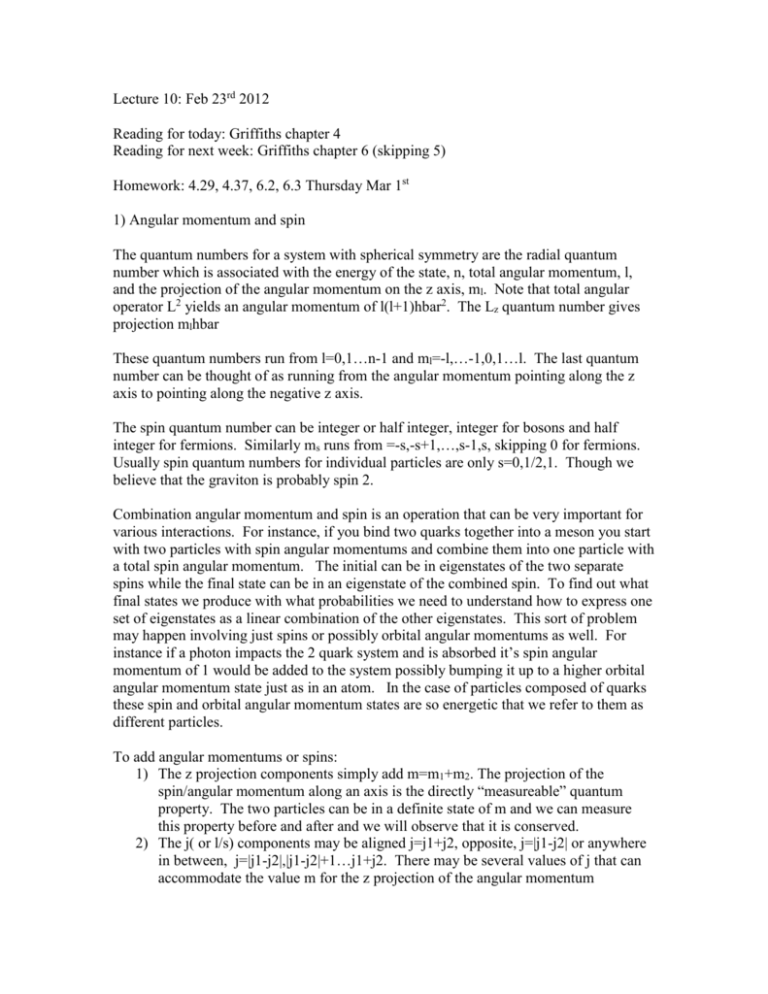
Lecture 10: Feb 23rd 2012 Reading for today: Griffiths chapter 4 Reading for next week: Griffiths chapter 6 (skipping 5) Homework: 4.29, 4.37, 6.2, 6.3 Thursday Mar 1st 1) Angular momentum and spin The quantum numbers for a system with spherical symmetry are the radial quantum number which is associated with the energy of the state, n, total angular momentum, l, and the projection of the angular momentum on the z axis, ml. Note that total angular operator L2 yields an angular momentum of l(l+1)hbar2. The Lz quantum number gives projection mlhbar These quantum numbers run from l=0,1…n-1 and ml=-l,…-1,0,1…l. The last quantum number can be thought of as running from the angular momentum pointing along the z axis to pointing along the negative z axis. The spin quantum number can be integer or half integer, integer for bosons and half integer for fermions. Similarly ms runs from =-s,-s+1,…,s-1,s, skipping 0 for fermions. Usually spin quantum numbers for individual particles are only s=0,1/2,1. Though we believe that the graviton is probably spin 2. Combination angular momentum and spin is an operation that can be very important for various interactions. For instance, if you bind two quarks together into a meson you start with two particles with spin angular momentums and combine them into one particle with a total spin angular momentum. The initial can be in eigenstates of the two separate spins while the final state can be in an eigenstate of the combined spin. To find out what final states we produce with what probabilities we need to understand how to express one set of eigenstates as a linear combination of the other eigenstates. This sort of problem may happen involving just spins or possibly orbital angular momentums as well. For instance if a photon impacts the 2 quark system and is absorbed it’s spin angular momentum of 1 would be added to the system possibly bumping it up to a higher orbital angular momentum state just as in an atom. In the case of particles composed of quarks these spin and orbital angular momentum states are so energetic that we refer to them as different particles. To add angular momentums or spins: 1) The z projection components simply add m=m1+m2. The projection of the spin/angular momentum along an axis is the directly “measureable” quantum property. The two particles can be in a definite state of m and we can measure this property before and after and we will observe that it is conserved. 2) The j( or l/s) components may be aligned j=j1+j2, opposite, j=|j1-j2| or anywhere in between, j=|j1-j2|,|j1-j2|+1…j1+j2. There may be several values of j that can accommodate the value m for the z projection of the angular momentum The coefficients that determine the relative probability of each allowed state are called the Clebsch-Gordan coefficients and can be looked up in the particle databook. They can also be derived by starting with the top state, which is trivial, using step down operators. Take the case of combining two spin ½ quarks. |s,m>=|s1,m1>|s2,m2> |1,1>=|1/2,1/2>|1/2,1/2> |1,0>=(1/2)(|1/2,-1/2>|1/2,1/2>+|1/2,-1/2>|1/2,1/2>) |1,-1>=|1/2,-1/2>|1/2,-1/2> vector mesons – symmetric wave function – example s=1 0 m = 776 MeV/c2 |0,0>=(1/2)(|1/2,-1/2>|1/2,1/2>-|1/2,-1/2>|1/2,1/2>) pseudoscalar mesons – antisymmetric wavefunction ,example s=0 0 m = 136 MeV/c2 Note, just as with the particle in a box the symmetric state is usually higher energy. Here, we can measure indirectly, though the mass, which total spin angular momentum state the particle is in. Quark states can also have orbital angular momentum. Example s=0 l=1 B m = 1229 MeV/c2 Consequences For the 0 since the two quarks are in a ms=0 state they can decays to two spin 1 photons, but the spins have to be oppositely aligned. This rate dominates. Similarly the rho can decay into two pions if in the ms=0 state. This is a strong decay so it dominates. If not in a ms=0(spins not aligned) the decay can still happen. However, there is going to be an angular distribution involved. Decay is favored along the axis where the ms=0. You end up with pions with relative l=1,ml=1 angular momentum to conserve total angular momentum. 2) Isospin Isospin is a symmetry related to flavor and the strong interaction. The proton and the neutron, or the up, down, and to some degree the strange quarks interact the in the same way with the strong interaction. They have the same possible colors and the same probability of interaction with the gluon. Therefore, they should have identical interactions but conserving weak flavor. This symmetry is approximate because the u and d quark and certainly the strange quark have different masses. Thus for instance pair production interactions are different. Define I and I3 I is going to lead to 2I+1 states delineated by I3=Q-1/2(A+S) which goes from –I to I in integer steps Q = charge, A = baryon number and S=strangeness Note I3 formula only works for mesons and baryons. This formula essentially conserves the total flavor projection in a similar way to to how spin projection keeps track of the total spin projection. Quark are consdired two aspects of the same particle to the strong force just as spin up and spin down particles are considered two aspects of the same particle to the electromagnetic force. Multiplets of isospin particles. Found by adding together the isospin of the individual quarks as angular momentums or spins are combined. Pions |I,I3> I = ½ + ½ = 1, I3 = -1, 0, 1 Pi+: u d : |1,1> = |½ ,½>|½ ,½> Pi0: u u or d d :|1,0> = (1/2)(|½ ,½>|½ ,-½> + |½ ,½>|½ ,-½>) Pi-= d u : |1,-1> = |½ ,-½>|½ ,-½> There is also singlet state. eta : u u or d d :|0,0> = (1/2)(|½ ,½>|½ ,-½> - |½ ,½>|½ ,-½>) Protons and neutrons |I,I3>: I = ½ + ½ - ½, I3 = -½,½. P=|1/2,1/2> N=|1/2,-1/2> Delta particles I = ½ + ½ + ½ = 3/2, I3 = -3/2, -1/2, 1/2, 3/2. ++: uuu: |3/2,3/2> +: uud |3/2,1/2> 0: udd, |3/2,-1/2> -: ddd |3/2,-3/2> Note that the two middle particles can be thought of as total isospin excited states of the proton and neutron. In this case, as with spin and angular momentum, when we do scattering experiments to determine the isospin we can only measure the isospin projection. However we can observe a consequence of being in the I=3/2 state in that the mass of the delta baryons is larger. Isospin helps us to figure out what combinations of quarks are allowed, which will have similar properties relative to the strong force, and whether they are expected to be more or less massive. These particles can also be in ground or excited spin and angular momentum states. To classify a particle and understand it’s interactions all these quantum numbers need to be determined. Since isospin is conserved in strong interaction it will have dynamical implication on strong scattering interactions. Isospin projection will have to be conserved which can decrease the probability of certain interactions occurring. Example: Consider the pion and nucleon colliding via the strong force. At first glance these all such processes happen at the same rate. To see the isospin effects we need a process that takes place through a definite eigenstate of the isospin quantum number, An example is pion nucleon at the CM energy of the . Consider pi+p: pi+p -> ++ -> pi+p pi-p: pi-p -> 0 -> pi-p To determine the probabilities we need to express the pi p eigenstates as a combination of the eigenstates pi+p=|1,1>|1/2,1/2>= |3/2,3/2> = ++ pi+p can only go the the ++. This expresses conservation of isospin projection. However, isospin projection is dependent on the quark content so it more fundamentally expresses conservation of charge(and strangeness – quark flavor). pi-p=|1,-1>|1/2>,1/2>=(1/3)|3/2,-1/2> - (2/3)|1/2,-1/2> 0=|3/2,-1/2> p=>|1/2>,1/2> However, at any energy the transition through a proton is forbidden by energy and momentum conservation. The probability to transition through to a 0 is 1/3 (reduced because the proton transition is not allowed). If this reaction happens at the energy of the Delta particles then the pi+p process has an amplitude three times as larger than the pi-p process at the delta particle energy. The cross section actually goes as the square of the amplitude so this process happens 9 times as often - you go from pi+p to the delta particle and then back again. Note when you observe unusual dynamical features in interactions it is often a consequence of some type of structure or symmetry, in this case the structure and symmetries of the quarks with regards to the strong force. 3) Parity Parity symmetry, P, is the inversion of all coordinates through the axis. The electromagnetic and strong interactions conserve parity. An interaction transformed using the parity operation happens at the same rate as the initial interaction. This is what we call a discrete transformation and can be represented by a finite group. In this case the Parity operator and identity operator. This is unlike the SU(2) and SO(3) groups which contain an infinite number of rotations. As with the other cases when there is a transformation of the system that leaves the probabilities of interaction unchanged there is a conserved quantity and eigenstates with quantum numbers of that property. The eigenstates of the parity have just two eigenvalues, +1 and -1. This could be deduced form the fact that clearly P2 = I = 1. For this to work +1 and -1 are the only possible eigenvalues. Interactions that respect parity conserve parity, where parity is accessed in a multiplicative way. i.e. interactions that respect parity conserve total parity, where total parity is the product of the parity of the individual particles involved. Note, any operation P such that P2 = I is a valid representation of the parity group. Therefore, in addition to inversion of all three coordinates, inversion or one or the equivalent inversion of two coordinates to is also a parity inversion and a parity respecting interaction will also be invariant under all of these transformations. We will often use the idea of a parity mirror to investigate parity ideas. The parity of the various particles can be determined as follows. The parity is the composite of its constituents. Quarks have positive parity and antiquarks negative parity. Photon and other vector particles also have negative parity. Angular momentum will be altered by the parity operation. There is an additional parity factor for particles with orbital angular momentum of (-1)l, since the wave functions are being inverted. Mesons in the s= 0, l=0, j=0 state with anti-parallel spins have parity -1 and are called pseudoscalars. The parity is simply set by the by the quark content. This differentiates them from a true scalar particle such as the Higgs, which has parity 1. Mesons in the s=1, l=0, j=1 state with parallel spins also have parity -1 are vectors. Again the parity is determined by the quark content. They have the same intrinsic spin as the photon and the same parity as the photon. The spin part doesn’t effect the parity. Mesons with spins anti-parallel in the s=0, l=1, j=1 are pseudo vectors or axial vectors and have positive parity. There is an extra factor of (-1)l and thus mesons in general have parity: -1*(-1)l Baryons have parity 1 while the anti-baryons have negative parity set by their quark content. Mesons have parity -1*(-1)l Baryons have parity 1*(-1)l Anti-baryons have parity -1*(-1)l The photon, a vector particle, has parity -1 Consequences: Example: pi0 -> Spin conservation spin 0 pion decays to two spin 1 photons. The spins of the photons must be anti parallel to conserve spin. Parity 1: If both photons had spin oriented along their direction of motion (helicity) then the parity operation will invert them to be oriented opposite to their direction of motion. These two interactions have to occur at the same rate. Parity 2: The pion is parity -1 and the photons are parity -1. Hey! This doesn’t conserve parity. You also have to consider the correlation of angular momentum between the photons. If they are oppositely polarized there is an additional factor of -1. An l=1 but ml = 0 state. In other cases the relative angular momentum between the particles will result in a specific angular distribution for the decay. A clearer example is the spin 0 parity -1 eta, which decays to three spin 0 parity -1 pions, but not to two. With no intrinsic spin or angular momentum to contribute to a final state angular momentum then only intrinsic parity conservation needs to be checked -1 = -1*1*-1 3) Charge conjugation. Charge conjugation, C, converts each particle into its antiparticle. It does not affect spin or angular momentum. This symmetry tells us that charge conjugated interactions should take place at the same rate as the initial interaction. This is a second discrete symmetry. Only particles that are their own antiparticles are eigenstates of charge conjugation. Similarly since C has two elements, C and I, and C2=I, C has eigenvalues +1 and -1. C is conserved as a product as is parity. The photon has C -1. The mesons that are also their own antiparticles have C (-1)l+s. Pseudoscalars mesons with s=0 and l=0 have C +1. Vector mesons with s=1 and l=0 have C -1. Mesons that are not their own antiparticles are not in eigenstates of the C operator so you don’t need to check for charge conjugation eigenvalue conservation. Though the charge conjugated interaction should still take place at the same rate. Example: pi0 s=0, l=0 pi0 -> +1 = -1*-1 Note C ignores the l angular momentum between the photons. The relative angular momentum is not changed by conjugating the charges. Example eta s=0, l=0 Eta -> pi0pi0pi0 +1 = +1*+1*+1 Example rho s=1, l=0 Rho -> pi0 pi0 -1 +1*+1 Not allowed by charge conjugation However rho -> pi+pi- is allowed since pi+ and pi- are not C eigenstates so you don’t have to conserve C. Note the rho -> pi+pi- decay must have relative angular momentum l=1 between the pions to conserve total angular momentum and parity. In addition you can form charge conjugation interactions from combinations of particles and anti-particles. ppbar -> pi+pi-pi0 In this interaction the charged pions must have similar energies or it’s not charge conjugation symmetric.

